Report on Diversity Management Strategies for CERA's HRM
VerifiedAdded on 2020/05/28
|16
|3653
|349
Report
AI Summary
This report provides a detailed overview of diversity management within CERA, a consulting organization in the civil construction industry. It emphasizes the importance of HRM in achieving business goals by creating a diverse workforce. The report discusses key components for managing diversity, including training programs, leadership support, and specific goals. It explores diversity management strategies, recruitment and selection processes, and the significance of investing in HR practices. The report also addresses gender diversity in leadership roles, challenges faced due to diversity, and strategies for managing these challenges, highlighting the need for communication, respect, and the prevention of discrimination. It offers a comprehensive analysis of how CERA can effectively manage diversity to enhance business performance and achieve its objectives.
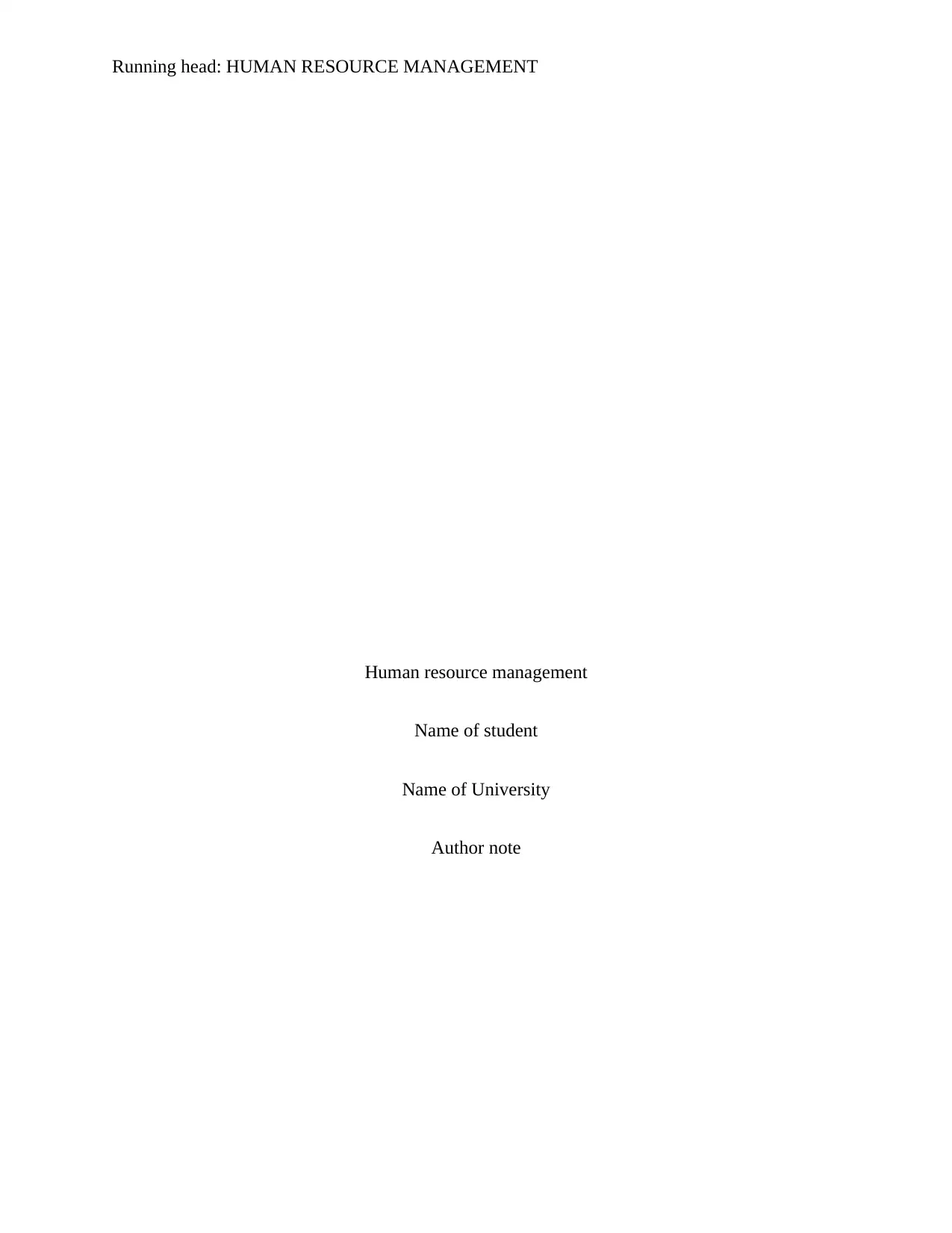
Running head: HUMAN RESOURCE MANAGEMENT
Human resource management
Name of student
Name of University
Author note
Human resource management
Name of student
Name of University
Author note
Paraphrase This Document
Need a fresh take? Get an instant paraphrase of this document with our AI Paraphraser
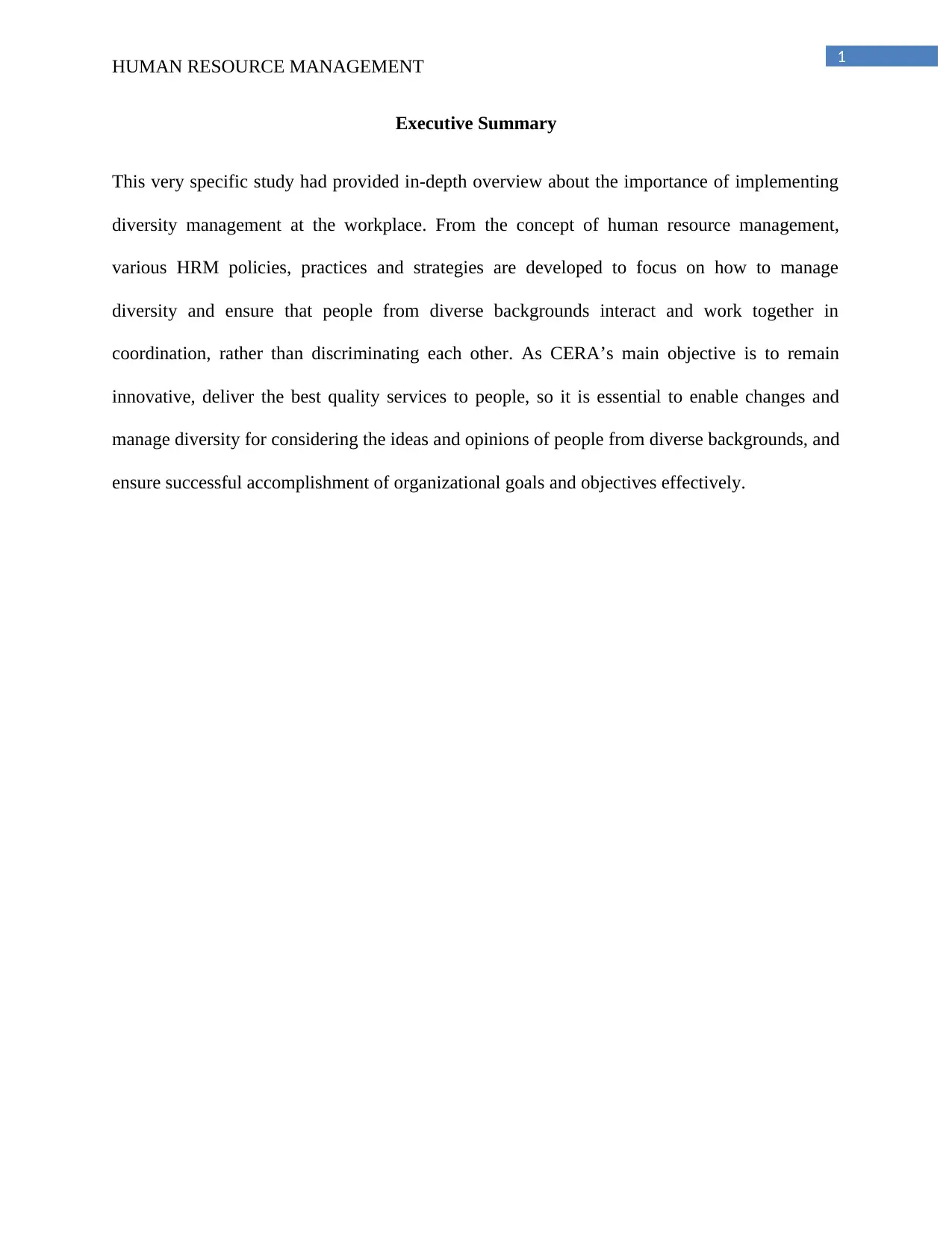
1
HUMAN RESOURCE MANAGEMENT
Executive Summary
This very specific study had provided in-depth overview about the importance of implementing
diversity management at the workplace. From the concept of human resource management,
various HRM policies, practices and strategies are developed to focus on how to manage
diversity and ensure that people from diverse backgrounds interact and work together in
coordination, rather than discriminating each other. As CERA’s main objective is to remain
innovative, deliver the best quality services to people, so it is essential to enable changes and
manage diversity for considering the ideas and opinions of people from diverse backgrounds, and
ensure successful accomplishment of organizational goals and objectives effectively.
HUMAN RESOURCE MANAGEMENT
Executive Summary
This very specific study had provided in-depth overview about the importance of implementing
diversity management at the workplace. From the concept of human resource management,
various HRM policies, practices and strategies are developed to focus on how to manage
diversity and ensure that people from diverse backgrounds interact and work together in
coordination, rather than discriminating each other. As CERA’s main objective is to remain
innovative, deliver the best quality services to people, so it is essential to enable changes and
manage diversity for considering the ideas and opinions of people from diverse backgrounds, and
ensure successful accomplishment of organizational goals and objectives effectively.
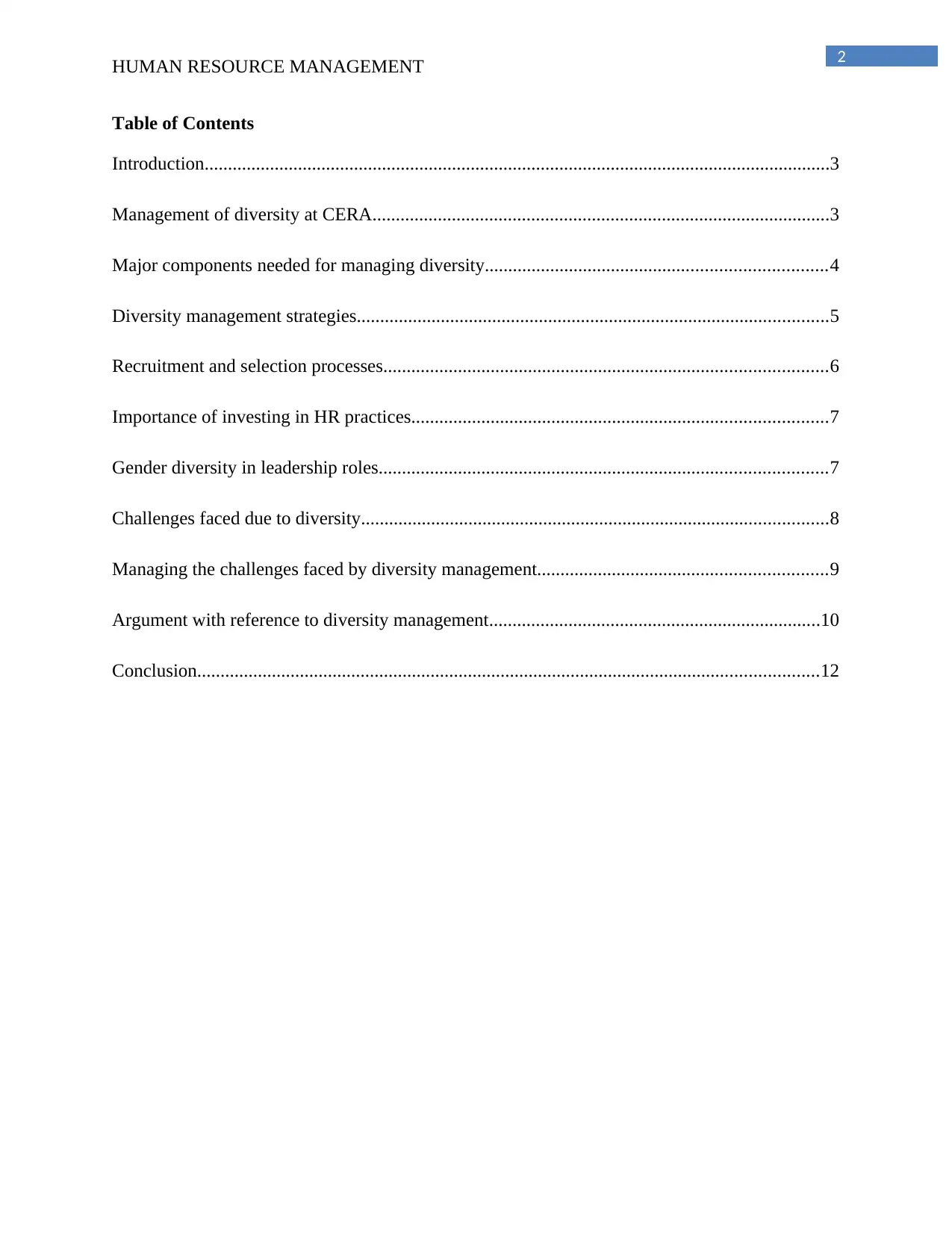
2
HUMAN RESOURCE MANAGEMENT
Table of Contents
Introduction......................................................................................................................................3
Management of diversity at CERA..................................................................................................3
Major components needed for managing diversity.........................................................................4
Diversity management strategies.....................................................................................................5
Recruitment and selection processes...............................................................................................6
Importance of investing in HR practices.........................................................................................7
Gender diversity in leadership roles................................................................................................7
Challenges faced due to diversity....................................................................................................8
Managing the challenges faced by diversity management..............................................................9
Argument with reference to diversity management.......................................................................10
Conclusion.....................................................................................................................................12
HUMAN RESOURCE MANAGEMENT
Table of Contents
Introduction......................................................................................................................................3
Management of diversity at CERA..................................................................................................3
Major components needed for managing diversity.........................................................................4
Diversity management strategies.....................................................................................................5
Recruitment and selection processes...............................................................................................6
Importance of investing in HR practices.........................................................................................7
Gender diversity in leadership roles................................................................................................7
Challenges faced due to diversity....................................................................................................8
Managing the challenges faced by diversity management..............................................................9
Argument with reference to diversity management.......................................................................10
Conclusion.....................................................................................................................................12
⊘ This is a preview!⊘
Do you want full access?
Subscribe today to unlock all pages.

Trusted by 1+ million students worldwide
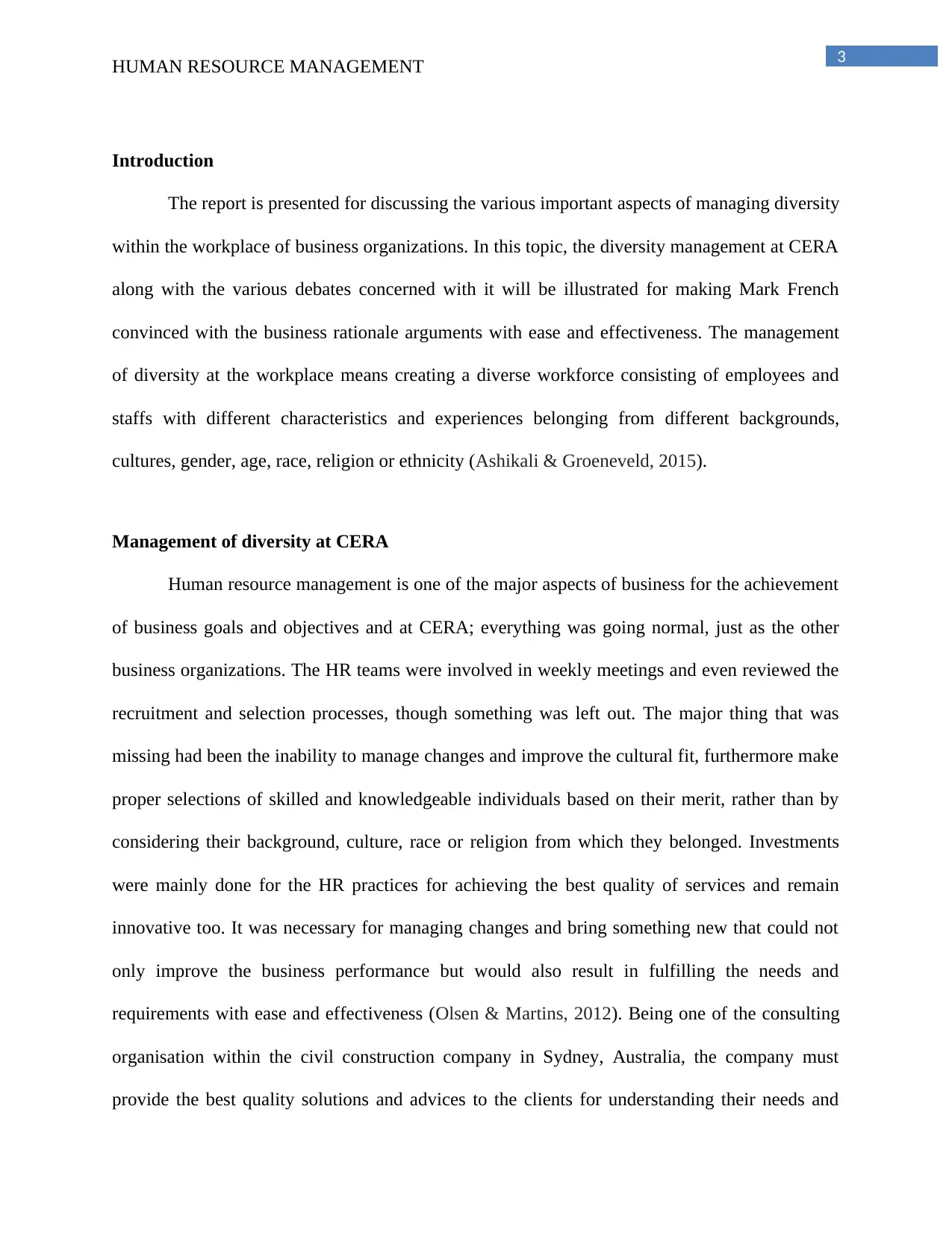
3
HUMAN RESOURCE MANAGEMENT
Introduction
The report is presented for discussing the various important aspects of managing diversity
within the workplace of business organizations. In this topic, the diversity management at CERA
along with the various debates concerned with it will be illustrated for making Mark French
convinced with the business rationale arguments with ease and effectiveness. The management
of diversity at the workplace means creating a diverse workforce consisting of employees and
staffs with different characteristics and experiences belonging from different backgrounds,
cultures, gender, age, race, religion or ethnicity (Ashikali & Groeneveld, 2015).
Management of diversity at CERA
Human resource management is one of the major aspects of business for the achievement
of business goals and objectives and at CERA; everything was going normal, just as the other
business organizations. The HR teams were involved in weekly meetings and even reviewed the
recruitment and selection processes, though something was left out. The major thing that was
missing had been the inability to manage changes and improve the cultural fit, furthermore make
proper selections of skilled and knowledgeable individuals based on their merit, rather than by
considering their background, culture, race or religion from which they belonged. Investments
were mainly done for the HR practices for achieving the best quality of services and remain
innovative too. It was necessary for managing changes and bring something new that could not
only improve the business performance but would also result in fulfilling the needs and
requirements with ease and effectiveness (Olsen & Martins, 2012). Being one of the consulting
organisation within the civil construction company in Sydney, Australia, the company must
provide the best quality solutions and advices to the clients for understanding their needs and
HUMAN RESOURCE MANAGEMENT
Introduction
The report is presented for discussing the various important aspects of managing diversity
within the workplace of business organizations. In this topic, the diversity management at CERA
along with the various debates concerned with it will be illustrated for making Mark French
convinced with the business rationale arguments with ease and effectiveness. The management
of diversity at the workplace means creating a diverse workforce consisting of employees and
staffs with different characteristics and experiences belonging from different backgrounds,
cultures, gender, age, race, religion or ethnicity (Ashikali & Groeneveld, 2015).
Management of diversity at CERA
Human resource management is one of the major aspects of business for the achievement
of business goals and objectives and at CERA; everything was going normal, just as the other
business organizations. The HR teams were involved in weekly meetings and even reviewed the
recruitment and selection processes, though something was left out. The major thing that was
missing had been the inability to manage changes and improve the cultural fit, furthermore make
proper selections of skilled and knowledgeable individuals based on their merit, rather than by
considering their background, culture, race or religion from which they belonged. Investments
were mainly done for the HR practices for achieving the best quality of services and remain
innovative too. It was necessary for managing changes and bring something new that could not
only improve the business performance but would also result in fulfilling the needs and
requirements with ease and effectiveness (Olsen & Martins, 2012). Being one of the consulting
organisation within the civil construction company in Sydney, Australia, the company must
provide the best quality solutions and advices to the clients for understanding their needs and
Paraphrase This Document
Need a fresh take? Get an instant paraphrase of this document with our AI Paraphraser
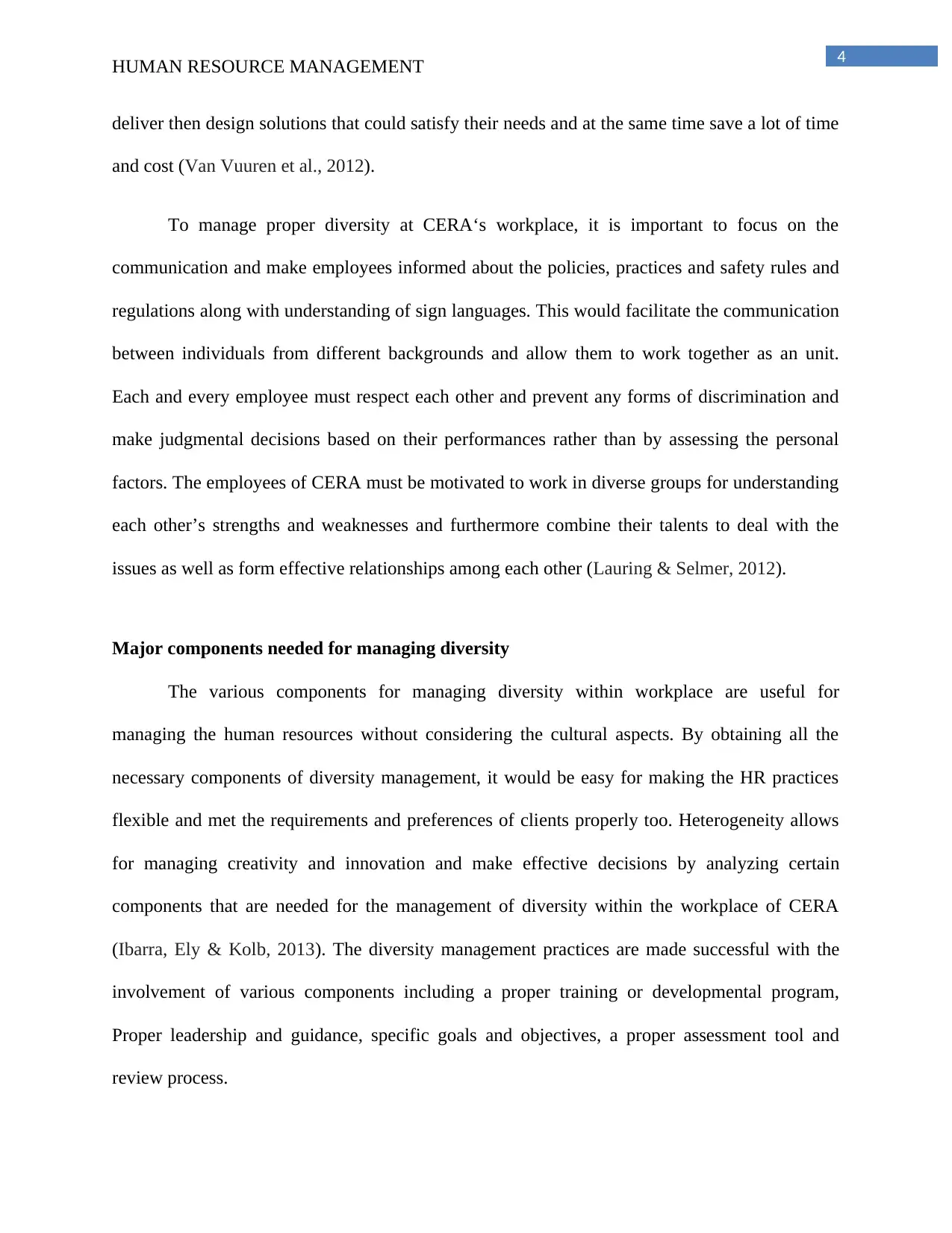
4
HUMAN RESOURCE MANAGEMENT
deliver then design solutions that could satisfy their needs and at the same time save a lot of time
and cost (Van Vuuren et al., 2012).
To manage proper diversity at CERA‘s workplace, it is important to focus on the
communication and make employees informed about the policies, practices and safety rules and
regulations along with understanding of sign languages. This would facilitate the communication
between individuals from different backgrounds and allow them to work together as an unit.
Each and every employee must respect each other and prevent any forms of discrimination and
make judgmental decisions based on their performances rather than by assessing the personal
factors. The employees of CERA must be motivated to work in diverse groups for understanding
each other’s strengths and weaknesses and furthermore combine their talents to deal with the
issues as well as form effective relationships among each other (Lauring & Selmer, 2012).
Major components needed for managing diversity
The various components for managing diversity within workplace are useful for
managing the human resources without considering the cultural aspects. By obtaining all the
necessary components of diversity management, it would be easy for making the HR practices
flexible and met the requirements and preferences of clients properly too. Heterogeneity allows
for managing creativity and innovation and make effective decisions by analyzing certain
components that are needed for the management of diversity within the workplace of CERA
(Ibarra, Ely & Kolb, 2013). The diversity management practices are made successful with the
involvement of various components including a proper training or developmental program,
Proper leadership and guidance, specific goals and objectives, a proper assessment tool and
review process.
HUMAN RESOURCE MANAGEMENT
deliver then design solutions that could satisfy their needs and at the same time save a lot of time
and cost (Van Vuuren et al., 2012).
To manage proper diversity at CERA‘s workplace, it is important to focus on the
communication and make employees informed about the policies, practices and safety rules and
regulations along with understanding of sign languages. This would facilitate the communication
between individuals from different backgrounds and allow them to work together as an unit.
Each and every employee must respect each other and prevent any forms of discrimination and
make judgmental decisions based on their performances rather than by assessing the personal
factors. The employees of CERA must be motivated to work in diverse groups for understanding
each other’s strengths and weaknesses and furthermore combine their talents to deal with the
issues as well as form effective relationships among each other (Lauring & Selmer, 2012).
Major components needed for managing diversity
The various components for managing diversity within workplace are useful for
managing the human resources without considering the cultural aspects. By obtaining all the
necessary components of diversity management, it would be easy for making the HR practices
flexible and met the requirements and preferences of clients properly too. Heterogeneity allows
for managing creativity and innovation and make effective decisions by analyzing certain
components that are needed for the management of diversity within the workplace of CERA
(Ibarra, Ely & Kolb, 2013). The diversity management practices are made successful with the
involvement of various components including a proper training or developmental program,
Proper leadership and guidance, specific goals and objectives, a proper assessment tool and
review process.
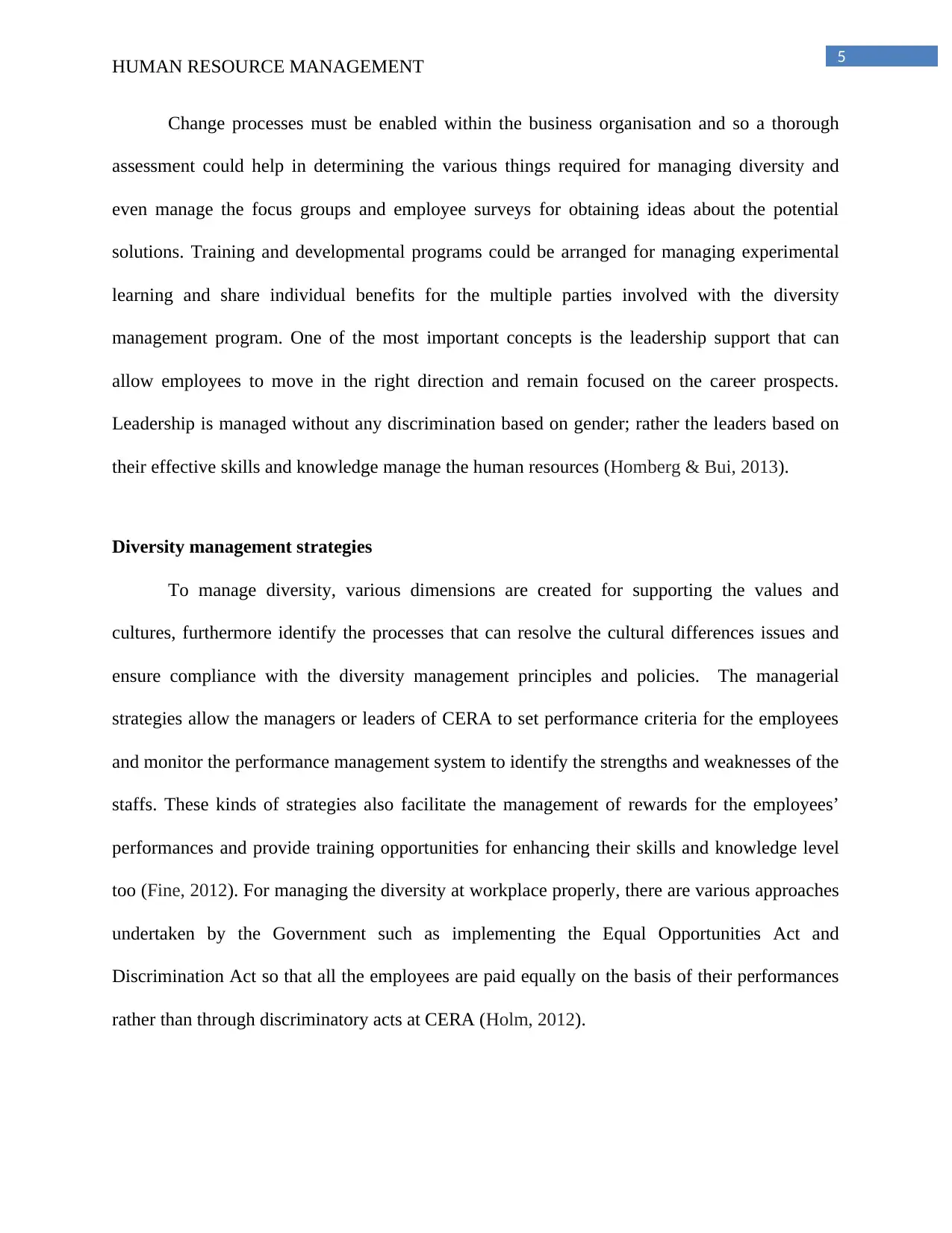
5
HUMAN RESOURCE MANAGEMENT
Change processes must be enabled within the business organisation and so a thorough
assessment could help in determining the various things required for managing diversity and
even manage the focus groups and employee surveys for obtaining ideas about the potential
solutions. Training and developmental programs could be arranged for managing experimental
learning and share individual benefits for the multiple parties involved with the diversity
management program. One of the most important concepts is the leadership support that can
allow employees to move in the right direction and remain focused on the career prospects.
Leadership is managed without any discrimination based on gender; rather the leaders based on
their effective skills and knowledge manage the human resources (Homberg & Bui, 2013).
Diversity management strategies
To manage diversity, various dimensions are created for supporting the values and
cultures, furthermore identify the processes that can resolve the cultural differences issues and
ensure compliance with the diversity management principles and policies. The managerial
strategies allow the managers or leaders of CERA to set performance criteria for the employees
and monitor the performance management system to identify the strengths and weaknesses of the
staffs. These kinds of strategies also facilitate the management of rewards for the employees’
performances and provide training opportunities for enhancing their skills and knowledge level
too (Fine, 2012). For managing the diversity at workplace properly, there are various approaches
undertaken by the Government such as implementing the Equal Opportunities Act and
Discrimination Act so that all the employees are paid equally on the basis of their performances
rather than through discriminatory acts at CERA (Holm, 2012).
HUMAN RESOURCE MANAGEMENT
Change processes must be enabled within the business organisation and so a thorough
assessment could help in determining the various things required for managing diversity and
even manage the focus groups and employee surveys for obtaining ideas about the potential
solutions. Training and developmental programs could be arranged for managing experimental
learning and share individual benefits for the multiple parties involved with the diversity
management program. One of the most important concepts is the leadership support that can
allow employees to move in the right direction and remain focused on the career prospects.
Leadership is managed without any discrimination based on gender; rather the leaders based on
their effective skills and knowledge manage the human resources (Homberg & Bui, 2013).
Diversity management strategies
To manage diversity, various dimensions are created for supporting the values and
cultures, furthermore identify the processes that can resolve the cultural differences issues and
ensure compliance with the diversity management principles and policies. The managerial
strategies allow the managers or leaders of CERA to set performance criteria for the employees
and monitor the performance management system to identify the strengths and weaknesses of the
staffs. These kinds of strategies also facilitate the management of rewards for the employees’
performances and provide training opportunities for enhancing their skills and knowledge level
too (Fine, 2012). For managing the diversity at workplace properly, there are various approaches
undertaken by the Government such as implementing the Equal Opportunities Act and
Discrimination Act so that all the employees are paid equally on the basis of their performances
rather than through discriminatory acts at CERA (Holm, 2012).
⊘ This is a preview!⊘
Do you want full access?
Subscribe today to unlock all pages.

Trusted by 1+ million students worldwide
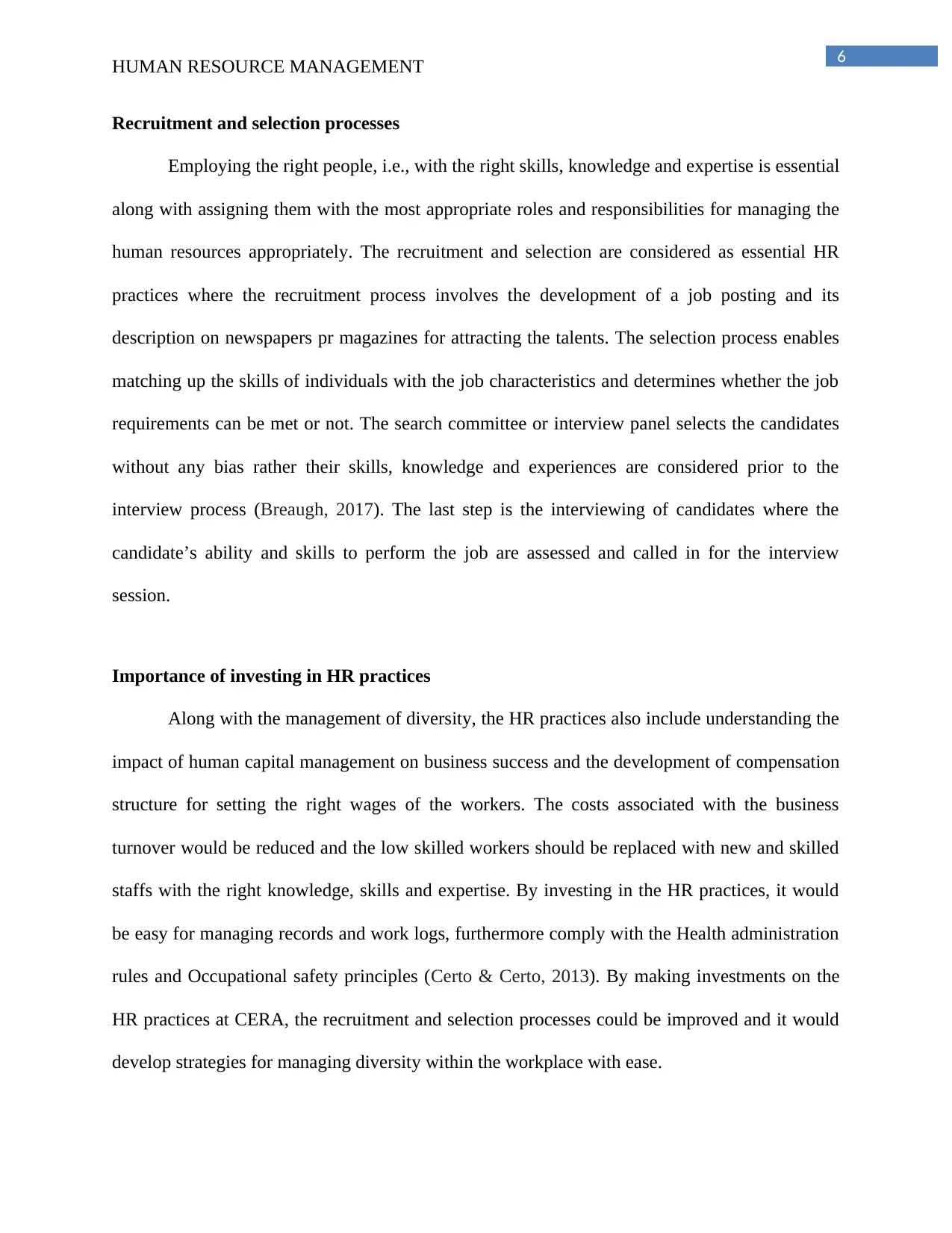
6
HUMAN RESOURCE MANAGEMENT
Recruitment and selection processes
Employing the right people, i.e., with the right skills, knowledge and expertise is essential
along with assigning them with the most appropriate roles and responsibilities for managing the
human resources appropriately. The recruitment and selection are considered as essential HR
practices where the recruitment process involves the development of a job posting and its
description on newspapers pr magazines for attracting the talents. The selection process enables
matching up the skills of individuals with the job characteristics and determines whether the job
requirements can be met or not. The search committee or interview panel selects the candidates
without any bias rather their skills, knowledge and experiences are considered prior to the
interview process (Breaugh, 2017). The last step is the interviewing of candidates where the
candidate’s ability and skills to perform the job are assessed and called in for the interview
session.
Importance of investing in HR practices
Along with the management of diversity, the HR practices also include understanding the
impact of human capital management on business success and the development of compensation
structure for setting the right wages of the workers. The costs associated with the business
turnover would be reduced and the low skilled workers should be replaced with new and skilled
staffs with the right knowledge, skills and expertise. By investing in the HR practices, it would
be easy for managing records and work logs, furthermore comply with the Health administration
rules and Occupational safety principles (Certo & Certo, 2013). By making investments on the
HR practices at CERA, the recruitment and selection processes could be improved and it would
develop strategies for managing diversity within the workplace with ease.
HUMAN RESOURCE MANAGEMENT
Recruitment and selection processes
Employing the right people, i.e., with the right skills, knowledge and expertise is essential
along with assigning them with the most appropriate roles and responsibilities for managing the
human resources appropriately. The recruitment and selection are considered as essential HR
practices where the recruitment process involves the development of a job posting and its
description on newspapers pr magazines for attracting the talents. The selection process enables
matching up the skills of individuals with the job characteristics and determines whether the job
requirements can be met or not. The search committee or interview panel selects the candidates
without any bias rather their skills, knowledge and experiences are considered prior to the
interview process (Breaugh, 2017). The last step is the interviewing of candidates where the
candidate’s ability and skills to perform the job are assessed and called in for the interview
session.
Importance of investing in HR practices
Along with the management of diversity, the HR practices also include understanding the
impact of human capital management on business success and the development of compensation
structure for setting the right wages of the workers. The costs associated with the business
turnover would be reduced and the low skilled workers should be replaced with new and skilled
staffs with the right knowledge, skills and expertise. By investing in the HR practices, it would
be easy for managing records and work logs, furthermore comply with the Health administration
rules and Occupational safety principles (Certo & Certo, 2013). By making investments on the
HR practices at CERA, the recruitment and selection processes could be improved and it would
develop strategies for managing diversity within the workplace with ease.
Paraphrase This Document
Need a fresh take? Get an instant paraphrase of this document with our AI Paraphraser
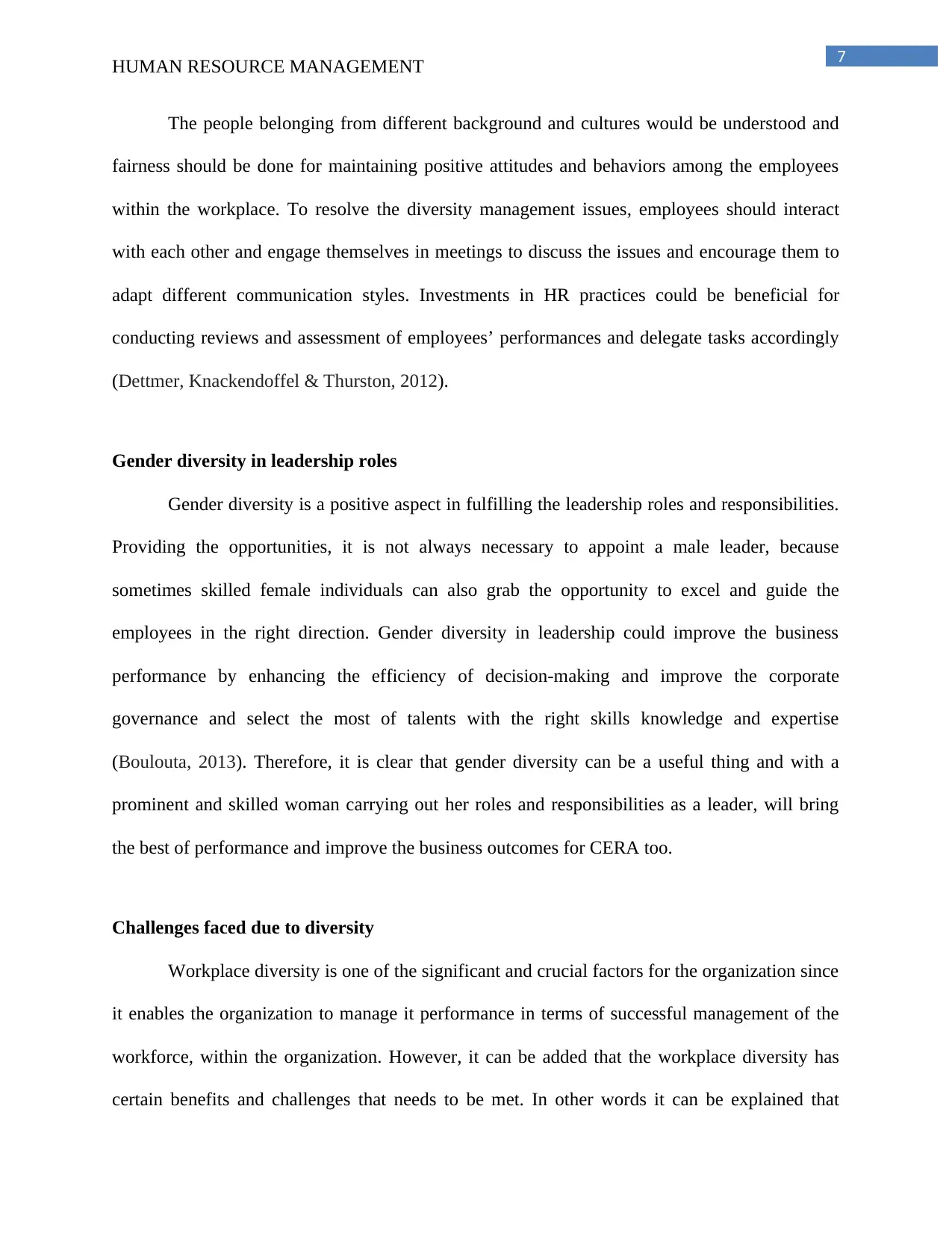
7
HUMAN RESOURCE MANAGEMENT
The people belonging from different background and cultures would be understood and
fairness should be done for maintaining positive attitudes and behaviors among the employees
within the workplace. To resolve the diversity management issues, employees should interact
with each other and engage themselves in meetings to discuss the issues and encourage them to
adapt different communication styles. Investments in HR practices could be beneficial for
conducting reviews and assessment of employees’ performances and delegate tasks accordingly
(Dettmer, Knackendoffel & Thurston, 2012).
Gender diversity in leadership roles
Gender diversity is a positive aspect in fulfilling the leadership roles and responsibilities.
Providing the opportunities, it is not always necessary to appoint a male leader, because
sometimes skilled female individuals can also grab the opportunity to excel and guide the
employees in the right direction. Gender diversity in leadership could improve the business
performance by enhancing the efficiency of decision-making and improve the corporate
governance and select the most of talents with the right skills knowledge and expertise
(Boulouta, 2013). Therefore, it is clear that gender diversity can be a useful thing and with a
prominent and skilled woman carrying out her roles and responsibilities as a leader, will bring
the best of performance and improve the business outcomes for CERA too.
Challenges faced due to diversity
Workplace diversity is one of the significant and crucial factors for the organization since
it enables the organization to manage it performance in terms of successful management of the
workforce, within the organization. However, it can be added that the workplace diversity has
certain benefits and challenges that needs to be met. In other words it can be explained that
HUMAN RESOURCE MANAGEMENT
The people belonging from different background and cultures would be understood and
fairness should be done for maintaining positive attitudes and behaviors among the employees
within the workplace. To resolve the diversity management issues, employees should interact
with each other and engage themselves in meetings to discuss the issues and encourage them to
adapt different communication styles. Investments in HR practices could be beneficial for
conducting reviews and assessment of employees’ performances and delegate tasks accordingly
(Dettmer, Knackendoffel & Thurston, 2012).
Gender diversity in leadership roles
Gender diversity is a positive aspect in fulfilling the leadership roles and responsibilities.
Providing the opportunities, it is not always necessary to appoint a male leader, because
sometimes skilled female individuals can also grab the opportunity to excel and guide the
employees in the right direction. Gender diversity in leadership could improve the business
performance by enhancing the efficiency of decision-making and improve the corporate
governance and select the most of talents with the right skills knowledge and expertise
(Boulouta, 2013). Therefore, it is clear that gender diversity can be a useful thing and with a
prominent and skilled woman carrying out her roles and responsibilities as a leader, will bring
the best of performance and improve the business outcomes for CERA too.
Challenges faced due to diversity
Workplace diversity is one of the significant and crucial factors for the organization since
it enables the organization to manage it performance in terms of successful management of the
workforce, within the organization. However, it can be added that the workplace diversity has
certain benefits and challenges that needs to be met. In other words it can be explained that
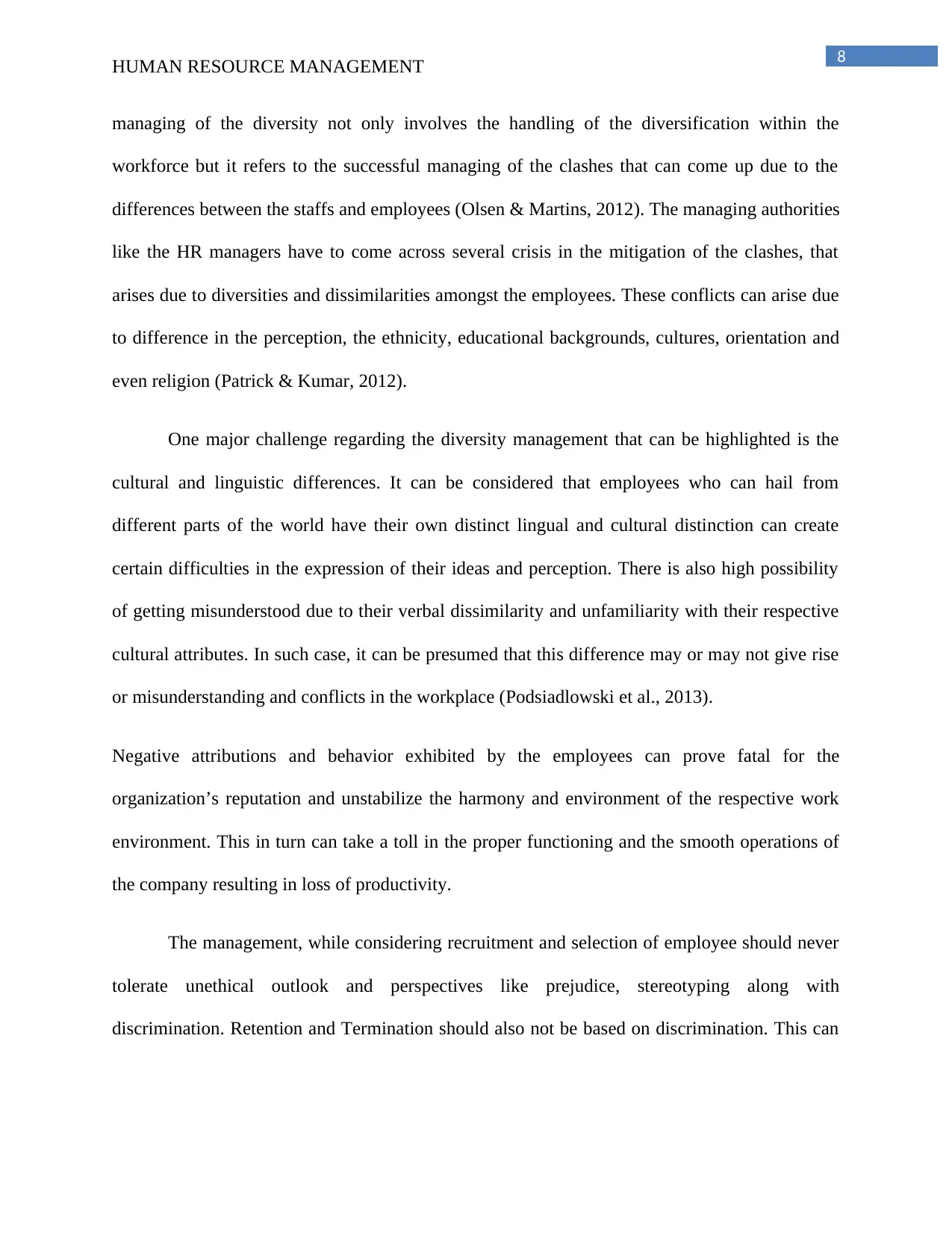
8
HUMAN RESOURCE MANAGEMENT
managing of the diversity not only involves the handling of the diversification within the
workforce but it refers to the successful managing of the clashes that can come up due to the
differences between the staffs and employees (Olsen & Martins, 2012). The managing authorities
like the HR managers have to come across several crisis in the mitigation of the clashes, that
arises due to diversities and dissimilarities amongst the employees. These conflicts can arise due
to difference in the perception, the ethnicity, educational backgrounds, cultures, orientation and
even religion (Patrick & Kumar, 2012).
One major challenge regarding the diversity management that can be highlighted is the
cultural and linguistic differences. It can be considered that employees who can hail from
different parts of the world have their own distinct lingual and cultural distinction can create
certain difficulties in the expression of their ideas and perception. There is also high possibility
of getting misunderstood due to their verbal dissimilarity and unfamiliarity with their respective
cultural attributes. In such case, it can be presumed that this difference may or may not give rise
or misunderstanding and conflicts in the workplace (Podsiadlowski et al., 2013).
Negative attributions and behavior exhibited by the employees can prove fatal for the
organization’s reputation and unstabilize the harmony and environment of the respective work
environment. This in turn can take a toll in the proper functioning and the smooth operations of
the company resulting in loss of productivity.
The management, while considering recruitment and selection of employee should never
tolerate unethical outlook and perspectives like prejudice, stereotyping along with
discrimination. Retention and Termination should also not be based on discrimination. This can
HUMAN RESOURCE MANAGEMENT
managing of the diversity not only involves the handling of the diversification within the
workforce but it refers to the successful managing of the clashes that can come up due to the
differences between the staffs and employees (Olsen & Martins, 2012). The managing authorities
like the HR managers have to come across several crisis in the mitigation of the clashes, that
arises due to diversities and dissimilarities amongst the employees. These conflicts can arise due
to difference in the perception, the ethnicity, educational backgrounds, cultures, orientation and
even religion (Patrick & Kumar, 2012).
One major challenge regarding the diversity management that can be highlighted is the
cultural and linguistic differences. It can be considered that employees who can hail from
different parts of the world have their own distinct lingual and cultural distinction can create
certain difficulties in the expression of their ideas and perception. There is also high possibility
of getting misunderstood due to their verbal dissimilarity and unfamiliarity with their respective
cultural attributes. In such case, it can be presumed that this difference may or may not give rise
or misunderstanding and conflicts in the workplace (Podsiadlowski et al., 2013).
Negative attributions and behavior exhibited by the employees can prove fatal for the
organization’s reputation and unstabilize the harmony and environment of the respective work
environment. This in turn can take a toll in the proper functioning and the smooth operations of
the company resulting in loss of productivity.
The management, while considering recruitment and selection of employee should never
tolerate unethical outlook and perspectives like prejudice, stereotyping along with
discrimination. Retention and Termination should also not be based on discrimination. This can
⊘ This is a preview!⊘
Do you want full access?
Subscribe today to unlock all pages.

Trusted by 1+ million students worldwide
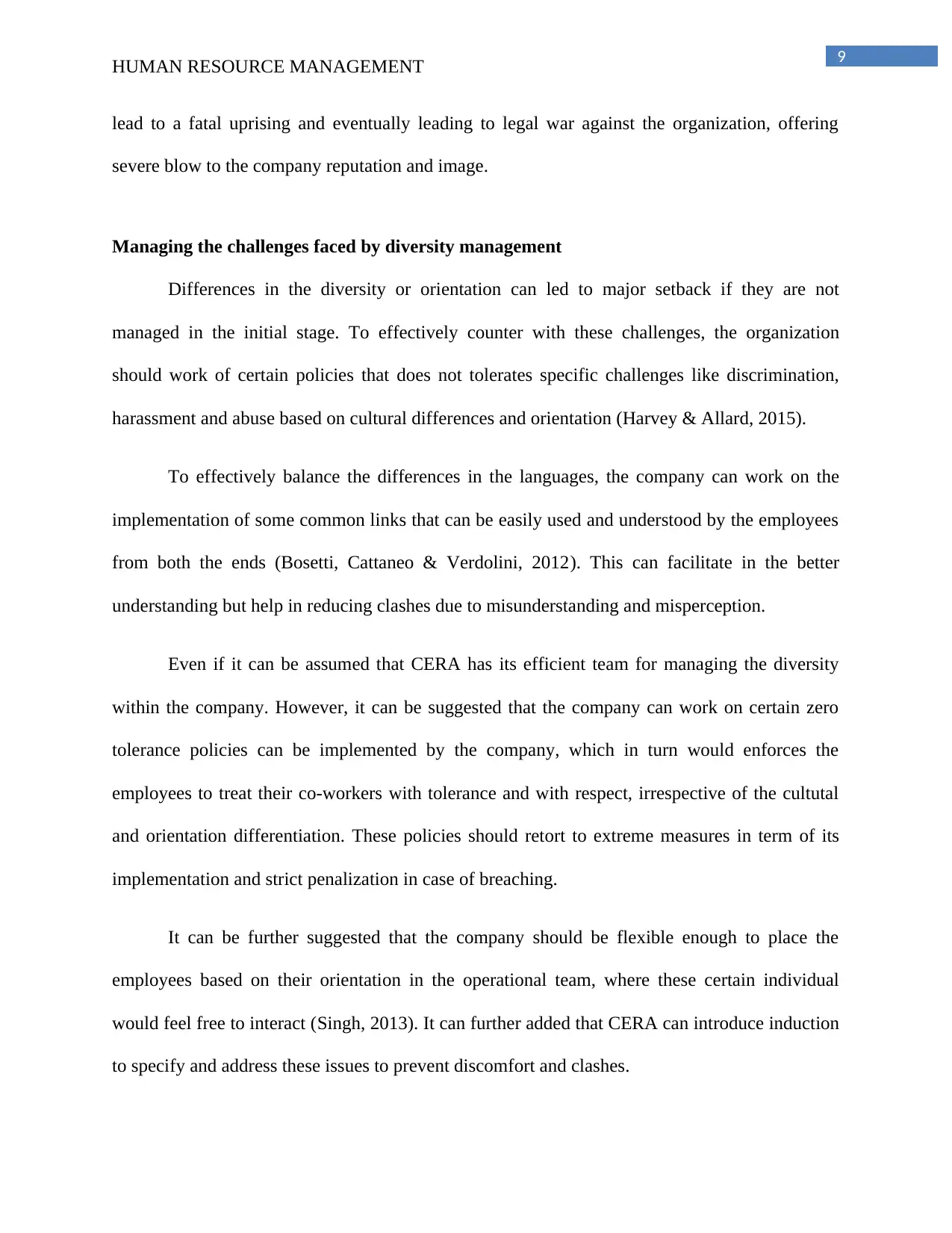
9
HUMAN RESOURCE MANAGEMENT
lead to a fatal uprising and eventually leading to legal war against the organization, offering
severe blow to the company reputation and image.
Managing the challenges faced by diversity management
Differences in the diversity or orientation can led to major setback if they are not
managed in the initial stage. To effectively counter with these challenges, the organization
should work of certain policies that does not tolerates specific challenges like discrimination,
harassment and abuse based on cultural differences and orientation (Harvey & Allard, 2015).
To effectively balance the differences in the languages, the company can work on the
implementation of some common links that can be easily used and understood by the employees
from both the ends (Bosetti, Cattaneo & Verdolini, 2012). This can facilitate in the better
understanding but help in reducing clashes due to misunderstanding and misperception.
Even if it can be assumed that CERA has its efficient team for managing the diversity
within the company. However, it can be suggested that the company can work on certain zero
tolerance policies can be implemented by the company, which in turn would enforces the
employees to treat their co-workers with tolerance and with respect, irrespective of the cultutal
and orientation differentiation. These policies should retort to extreme measures in term of its
implementation and strict penalization in case of breaching.
It can be further suggested that the company should be flexible enough to place the
employees based on their orientation in the operational team, where these certain individual
would feel free to interact (Singh, 2013). It can further added that CERA can introduce induction
to specify and address these issues to prevent discomfort and clashes.
HUMAN RESOURCE MANAGEMENT
lead to a fatal uprising and eventually leading to legal war against the organization, offering
severe blow to the company reputation and image.
Managing the challenges faced by diversity management
Differences in the diversity or orientation can led to major setback if they are not
managed in the initial stage. To effectively counter with these challenges, the organization
should work of certain policies that does not tolerates specific challenges like discrimination,
harassment and abuse based on cultural differences and orientation (Harvey & Allard, 2015).
To effectively balance the differences in the languages, the company can work on the
implementation of some common links that can be easily used and understood by the employees
from both the ends (Bosetti, Cattaneo & Verdolini, 2012). This can facilitate in the better
understanding but help in reducing clashes due to misunderstanding and misperception.
Even if it can be assumed that CERA has its efficient team for managing the diversity
within the company. However, it can be suggested that the company can work on certain zero
tolerance policies can be implemented by the company, which in turn would enforces the
employees to treat their co-workers with tolerance and with respect, irrespective of the cultutal
and orientation differentiation. These policies should retort to extreme measures in term of its
implementation and strict penalization in case of breaching.
It can be further suggested that the company should be flexible enough to place the
employees based on their orientation in the operational team, where these certain individual
would feel free to interact (Singh, 2013). It can further added that CERA can introduce induction
to specify and address these issues to prevent discomfort and clashes.
Paraphrase This Document
Need a fresh take? Get an instant paraphrase of this document with our AI Paraphraser
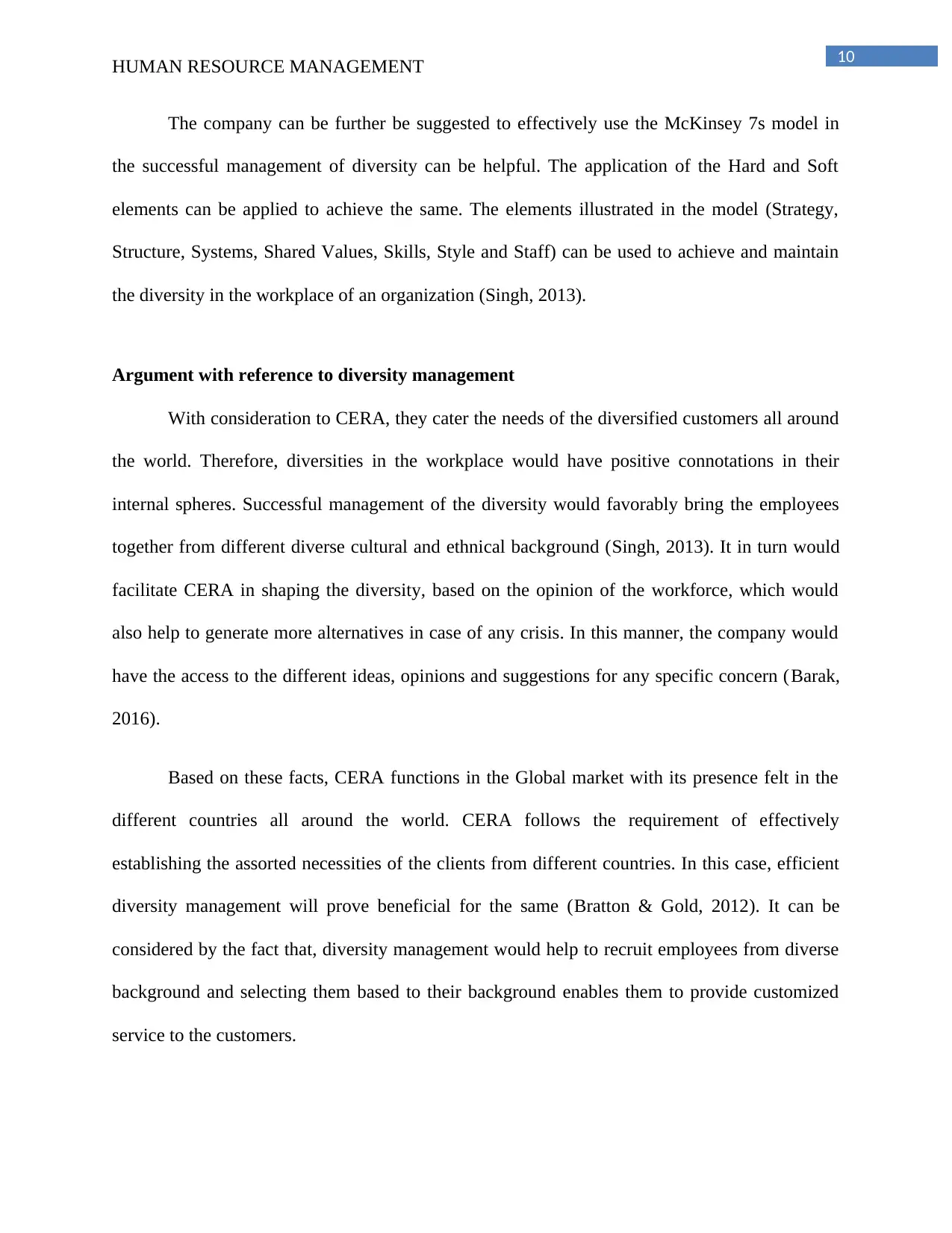
10
HUMAN RESOURCE MANAGEMENT
The company can be further be suggested to effectively use the McKinsey 7s model in
the successful management of diversity can be helpful. The application of the Hard and Soft
elements can be applied to achieve the same. The elements illustrated in the model (Strategy,
Structure, Systems, Shared Values, Skills, Style and Staff) can be used to achieve and maintain
the diversity in the workplace of an organization (Singh, 2013).
Argument with reference to diversity management
With consideration to CERA, they cater the needs of the diversified customers all around
the world. Therefore, diversities in the workplace would have positive connotations in their
internal spheres. Successful management of the diversity would favorably bring the employees
together from different diverse cultural and ethnical background (Singh, 2013). It in turn would
facilitate CERA in shaping the diversity, based on the opinion of the workforce, which would
also help to generate more alternatives in case of any crisis. In this manner, the company would
have the access to the different ideas, opinions and suggestions for any specific concern (Barak,
2016).
Based on these facts, CERA functions in the Global market with its presence felt in the
different countries all around the world. CERA follows the requirement of effectively
establishing the assorted necessities of the clients from different countries. In this case, efficient
diversity management will prove beneficial for the same (Bratton & Gold, 2012). It can be
considered by the fact that, diversity management would help to recruit employees from diverse
background and selecting them based to their background enables them to provide customized
service to the customers.
HUMAN RESOURCE MANAGEMENT
The company can be further be suggested to effectively use the McKinsey 7s model in
the successful management of diversity can be helpful. The application of the Hard and Soft
elements can be applied to achieve the same. The elements illustrated in the model (Strategy,
Structure, Systems, Shared Values, Skills, Style and Staff) can be used to achieve and maintain
the diversity in the workplace of an organization (Singh, 2013).
Argument with reference to diversity management
With consideration to CERA, they cater the needs of the diversified customers all around
the world. Therefore, diversities in the workplace would have positive connotations in their
internal spheres. Successful management of the diversity would favorably bring the employees
together from different diverse cultural and ethnical background (Singh, 2013). It in turn would
facilitate CERA in shaping the diversity, based on the opinion of the workforce, which would
also help to generate more alternatives in case of any crisis. In this manner, the company would
have the access to the different ideas, opinions and suggestions for any specific concern (Barak,
2016).
Based on these facts, CERA functions in the Global market with its presence felt in the
different countries all around the world. CERA follows the requirement of effectively
establishing the assorted necessities of the clients from different countries. In this case, efficient
diversity management will prove beneficial for the same (Bratton & Gold, 2012). It can be
considered by the fact that, diversity management would help to recruit employees from diverse
background and selecting them based to their background enables them to provide customized
service to the customers.
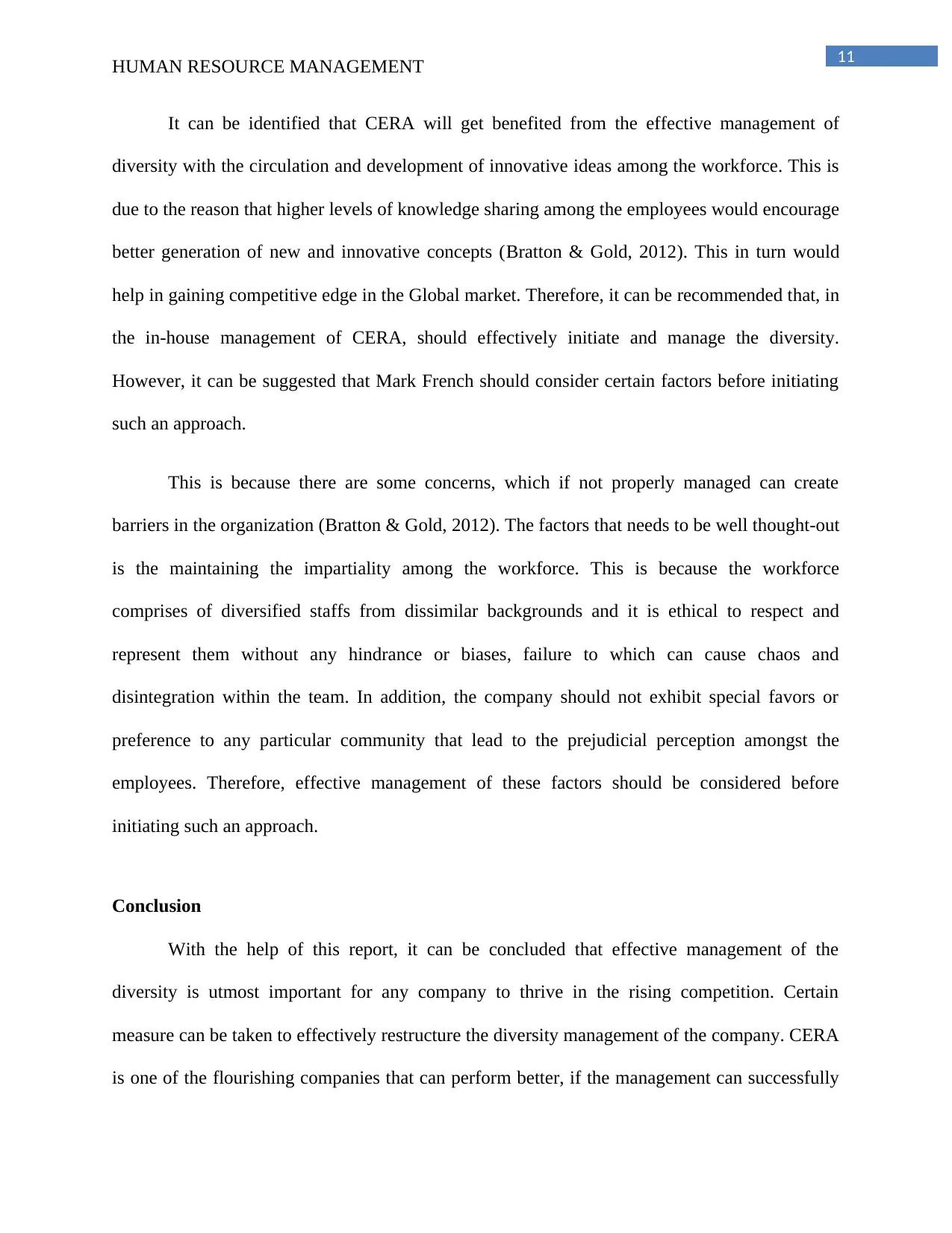
11
HUMAN RESOURCE MANAGEMENT
It can be identified that CERA will get benefited from the effective management of
diversity with the circulation and development of innovative ideas among the workforce. This is
due to the reason that higher levels of knowledge sharing among the employees would encourage
better generation of new and innovative concepts (Bratton & Gold, 2012). This in turn would
help in gaining competitive edge in the Global market. Therefore, it can be recommended that, in
the in-house management of CERA, should effectively initiate and manage the diversity.
However, it can be suggested that Mark French should consider certain factors before initiating
such an approach.
This is because there are some concerns, which if not properly managed can create
barriers in the organization (Bratton & Gold, 2012). The factors that needs to be well thought-out
is the maintaining the impartiality among the workforce. This is because the workforce
comprises of diversified staffs from dissimilar backgrounds and it is ethical to respect and
represent them without any hindrance or biases, failure to which can cause chaos and
disintegration within the team. In addition, the company should not exhibit special favors or
preference to any particular community that lead to the prejudicial perception amongst the
employees. Therefore, effective management of these factors should be considered before
initiating such an approach.
Conclusion
With the help of this report, it can be concluded that effective management of the
diversity is utmost important for any company to thrive in the rising competition. Certain
measure can be taken to effectively restructure the diversity management of the company. CERA
is one of the flourishing companies that can perform better, if the management can successfully
HUMAN RESOURCE MANAGEMENT
It can be identified that CERA will get benefited from the effective management of
diversity with the circulation and development of innovative ideas among the workforce. This is
due to the reason that higher levels of knowledge sharing among the employees would encourage
better generation of new and innovative concepts (Bratton & Gold, 2012). This in turn would
help in gaining competitive edge in the Global market. Therefore, it can be recommended that, in
the in-house management of CERA, should effectively initiate and manage the diversity.
However, it can be suggested that Mark French should consider certain factors before initiating
such an approach.
This is because there are some concerns, which if not properly managed can create
barriers in the organization (Bratton & Gold, 2012). The factors that needs to be well thought-out
is the maintaining the impartiality among the workforce. This is because the workforce
comprises of diversified staffs from dissimilar backgrounds and it is ethical to respect and
represent them without any hindrance or biases, failure to which can cause chaos and
disintegration within the team. In addition, the company should not exhibit special favors or
preference to any particular community that lead to the prejudicial perception amongst the
employees. Therefore, effective management of these factors should be considered before
initiating such an approach.
Conclusion
With the help of this report, it can be concluded that effective management of the
diversity is utmost important for any company to thrive in the rising competition. Certain
measure can be taken to effectively restructure the diversity management of the company. CERA
is one of the flourishing companies that can perform better, if the management can successfully
⊘ This is a preview!⊘
Do you want full access?
Subscribe today to unlock all pages.

Trusted by 1+ million students worldwide
1 out of 16
Related Documents
Your All-in-One AI-Powered Toolkit for Academic Success.
+13062052269
info@desklib.com
Available 24*7 on WhatsApp / Email
![[object Object]](/_next/static/media/star-bottom.7253800d.svg)
Unlock your academic potential
Copyright © 2020–2025 A2Z Services. All Rights Reserved. Developed and managed by ZUCOL.





